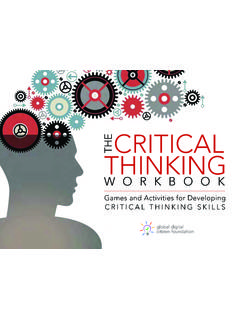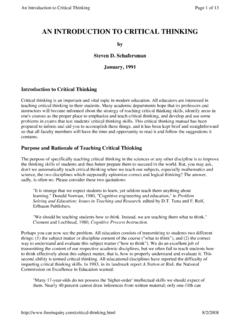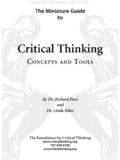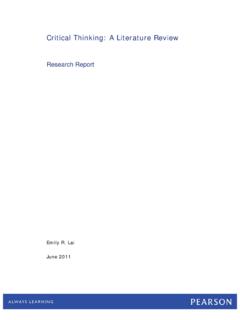Transcription of Using Critical Thinking Teaching Methods to Increase ...
1 International Journal of Teaching and Learning in Higher Education 2017, Volume 29, Number 1, 17-32. ISSN 1812-9129. Using Critical Thinking Teaching Methods to Increase Student Success: An Action Research Project Herbert Nold Polk State College Numerous studies and United States Department of Education reports indicate that university graduates lack Critical Thinking and problem solving skills that are needed for success in both the classroom and the modern workplace. Success in the classroom and workplace is a function of many attributes that change with the situation, but the ability to synthesize complex relationships and identify potential solutions to problems or innovation is a core competency. In this action research project, the curriculum in three business courses were modified to include and emphasize activities that research suggests help develop Critical Thinking . The Motivated Strategies for Learning Questionnaire (MSLQ) (Pintrich, Smith, Garcia, & McKeachie, 1991) was used to assess changes in 15 learning constructs during a class and correlated with grades.
2 A modified MSLQ (Boyer &. Usinger, 2012) was administered at the beginning and end of eight-week courses to provide insight into how students self-assess constructs for success. Results from classes over a 15-month period in 2013 and 2014 indicated improvement in 14 of 15 elements for success with three (intrinsic goal orientation, self-efficacy, and Critical Thinking ) statistically significant. Developing Critical Thinking skills needed for many college faculty do not fully understand how to success beyond the classroom has been recognized as a effectively teach Critical Thinking or develop higher primary goal of colleges and universities (Astin, 1993; order cognitive abilities and are not able to incorporate Gellin, 2003; Stedman & Adams, 2012). In a survey of Critical Thinking exercises into course curricula (Ahuna 433 institutions of higher learning 95% of the chief et al., 2014; Lauer, 2005; Paul, Elder & Bartell, 1997, academic officers identified Critical Thinking as one of Shim & Walczak, 2012).
3 Many college faculty the most important skills for students and noted that proclaim to encourage students to develop higher order 81% of employers wanted universities to place a cognitive skills and Critical Thinking yet use a lecture stronger emphasis on developing Critical Thinking skills format and focus student assignments and efforts on (AAC&U, 2011). The emergence of a knowledge-based memorization and lower level cognitive tasks which do economy over a once dominant manufacturing not encourage Critical Thinking (Ahuna et al., 2014;. economy means that positive outcomes are dependent Duron, Limback, & Waugh, 2006). A literature review on Critical Thinking abilities (Abrami et al., 2008; by Beyer (2001) found that many high school and Ahuna, Tinnesz & Keiner, 2014; Meepian & college students lack higher order Critical Thinking skills Wannapiroon, 2013). needed to be successful in postsecondary education or While no universal definition of Critical Thinking in chosen careers.
4 Has been identified, Liu, Frankel, and Roohr (2014) While general mental ability including Critical evaluated seven Critical Thinking frameworks to identify Thinking is one of the strongest predictors of long-term common elements. Critical Thinking involves much success in the workplace, many other factors determine more than accumulating information or processing success such as motivation, confidence, and time information, rather Critical Thinking involves management skills that exist in a dynamic system that identifying, analyzing, synthesizing, and evaluating changes with every situation (Rode, Arthaud-Day, information to yield actionable knowledge to make Mooney, Near & Baldwin, 2008). In the action research effective decisions (Argyris, 1996; Giancarlo & project being reported, Methods identified in research that Facione, 2001; Liu et al., 2011; Scriven & Paul, 2005). help develop Critical Thinking and higher order cognition Alwehaibi (2012) summarized Critical Thinking as the were incorporated into business classes, and constructs ability not just to acquire knowledge but also to make identified for success in the classroom and workplace were sense of new information.
5 Yet despite Critical Thinking assessed in a pre- and post-course assessment. being identified as an important educational objective, strong evidence exists indicating that many college Background graduates lack Critical Thinking skills needed for success in the modern workplace (Ahuna et al., 2014; Gellin, Prior Research on Critical Thinking 2003; Shim & Walczak, 2012; Department of Education, 2006). Further, even though developing The pressure on educational institutions and Critical Thinking is generally recognized as an important educators at all levels to provide quantitative educational objective, evidence exists suggesting that assessment of educational progress through Nold Critical Thinking Teaching Methods 18. standardized testing has been building for decades including Critical Thinking . Taken as a whole, the (Snyder & Dillow, 2012). Compliance with the MSLQ constructs identify skills or attributes that are federally mandated No Child Left Behind legislation is necessary for success in school and the workplace.
6 By based on the ability of educational institutions to correlating MSLQ scores with success in school, as demonstrate that all students are academically measured by grades, the Boyer and Usinger study proficient Using state-mandated standardized tests by offered insight into the effectiveness of college faculty the 2014-2015 school year (Bigham & Riney, 2014). in developing Critical Thinking and other attributes that Faculties at colleges are now being required to supply are keys for success both in school and the workplace. documentation demonstrating that learning is taking Results from the Boyer and Usinger study indicated that place. While logical on the surface, measuring and two of the 15 MSLQ constructs have an impact on documenting learning is a difficult task, but the grades self-efficacy and time/study management . simplest and easiest way is to assess the accumulation with just self-efficacy emerging as a significant of facts or figures.
7 Whether because of pressure for predictor of success grades. Further: quantifiable assessments, simple effort for efficiency, or a tradition of lecture, faculty at institutions of higher [C]ritical Thinking or meta-cognitive self- learning tend to use lectures as the primary means of regulation play an insignificant or negative role in communicating content and focus tasks on predicting course outcomes. It appears that students memorization and lower-order cognitive assignments are producing positive course outcomes without (Duron et al., 2006). Many teachers claim to indirectly utilizing these learning strategies for their course attempt to teach students Critical Thinking skills; success. Furthermore, while this might reflect a however, most students do not master the skill (Fisher, general absence of some underlying and more 2007). Paul and colleagues (1997) found that many advanced learning concepts, it might also indicate instructors in California possess only a vague that faculty cultivates students who are successful understanding of what Critical Thinking is and, not as compliant learners rather than questioning surprisingly, little knowledge on how to develop Critical why a concept of principle is correct (p.)
8 18). Thinking skills in students. The Paul, Elder, and Bartell study found that while 89% of the sampled instructors This condition should not be surprising considering identified Critical Thinking as a primary objective, only the evidence that most college faculty lack 9% included tasks in class that were clearly designed to understanding on Critical Thinking or how to help promote Critical Thinking on a typical day in class. More students develop this important ability. If one accepts current, numerous studies have found that high school the findings of Alwehaibi (2012), then the question teachers and university faculty lack basic knowledge or becomes, What practices should college faculty understanding of Critical Thinking or how to incorporate integrate into course tasks to help students improve in such Thinking into lesson plans so that Critical Thinking Critical Thinking and other key attributes for success? . can be developed in students (Bataineh & Alazzi, 2009; The action research project described in this paper was Innabi & El Sheikh, 2007; Lauer, 2005; Stapleton, designed to provide insight into the question of whether 2011; Thurman, 2009).
9 Yet, Alwehaibi (2012) found integrating Critical Thinking tasks into course designs that Critical Thinking and overall student success could will help students improve attributes needed for success be improved if institutions of higher learning adopt and both in the classroom and in the workforce. integrate strategies and techniques that have been identified as helpful in developing Critical Thinking into Prior Studies on the Basic Question various courses. Additionally, Abrami and colleagues (2008) found that instructors who received specific Multiple researchers have explored educational training on Methods to teach Critical Thinking were more practices that help develop Critical Thinking and higher effective in developing Critical Thinking in students than order cognitive skills. Smith (1977) identified three kinds instructors who had no prior training. of classroom interactions that consistently yield positive results in Critical Thinking : faculty members positively The Basic Question reinforcing students with encouragement, praise, or use of student generated ideas; student participation in class Boyer and Usinger (2013) administered a modified with high levels of cognitive questioning and answering.
10 Motivated Strategies for Learning Questionnaire and student interaction during a course. Astin (1993). (MSLQ) to 1,513 first and second year students at a went further to identify specific assignments to be four-year public college in multiple subject areas with beneficial in promoting self-reported Critical Thinking , both face-to-face and online classes. The MSLQ is a such as making presentations in class and providing self-assessment instrument aligned to a particular detailed critiques and positive feedback on written learning context providing insight into 15 constructs, assignments. Tsui (1999) offered additional insight into Nold Critical Thinking Teaching Methods 19. self-reported growth in Critical Thinking . Tsui found that and evaluate relevant information, approach a question detailed feedback from the instructor on written objectively, communicate effectively, and derive well- assignments, conducting of independent research, work reasoned, logical conclusions for complex problems.















